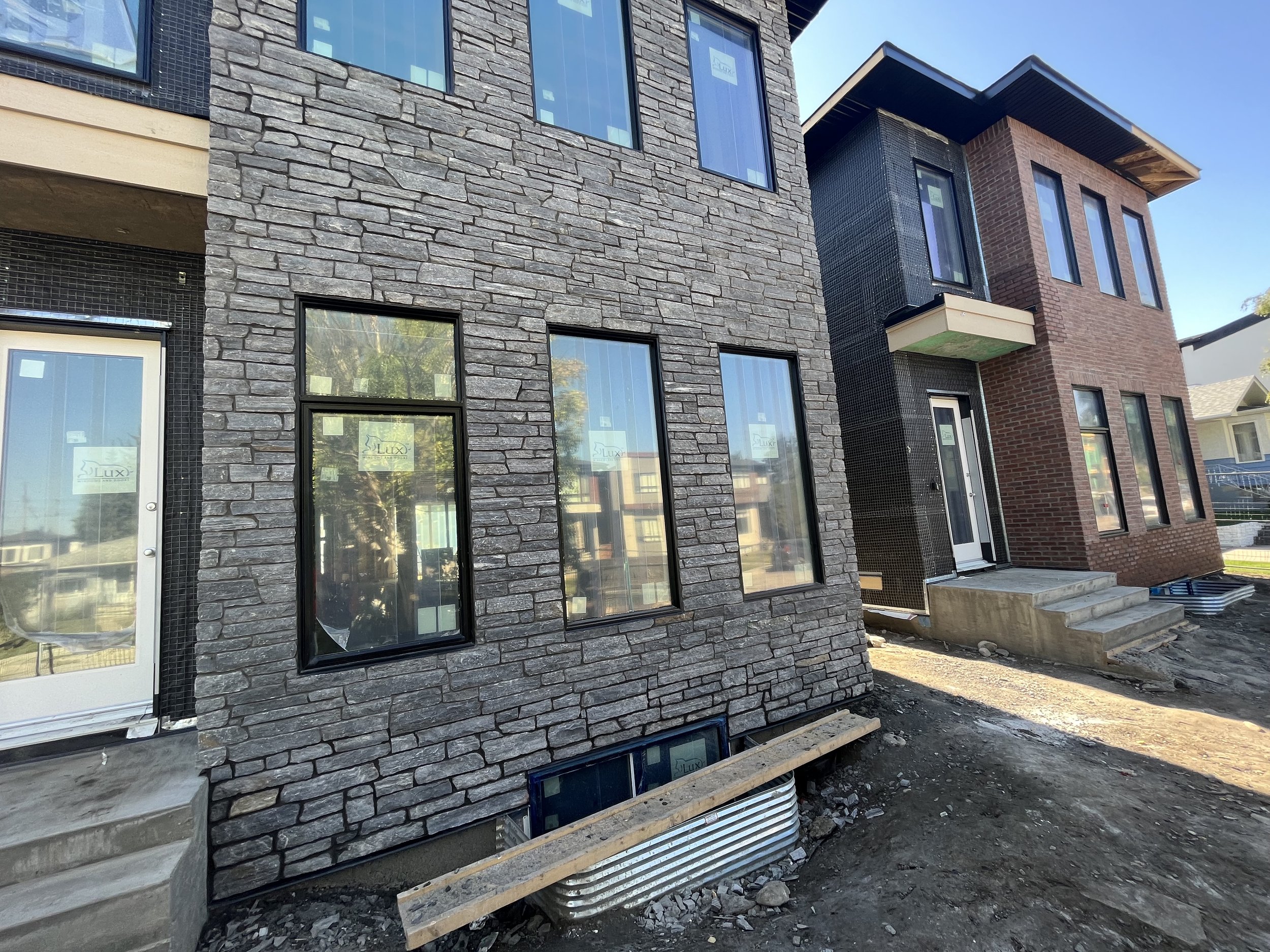This post is a discussion, not of how to create value in the infill marketplace, but how to survive personally while doing so. Earlier post mention the personal cost of enduring, or surviving, the development game, with all of its intrinsic stress and hardship, and above all, the risk. How does one best organize his/her personal affairs while chasing the dream of operating, full time, as a real estate investor and developer? Recall the old real estate investing joke, Q - ‘How do you know when it is time to quit your job to become a real estate investor?’ A - Does your spouse have a job? If yes, you can become a full time real estate investor.
Imagine the monthly cost of the fledgling infill developer. Housing, food, insurance, transportation, let’s estimate that at $5k/mo. Once committed to that first project, the fixed cost of living endures regardless of wage income, or lack of. The final outcome, a complete project, leased up, or sold, is a distant vision. After a land deal is under contract, planning starts, permitting likely takes 6 months. Construction is approximately 12 months. This new developer has locked in a personal cost of 18 months of living expense, while chasing the dream of creating massive value. Regardless of the success of the project, $90k is now earmarked for survival during the build. Take a construction budget, call it $1MM. 9% of this is now added to the project cost as the owners overhead. The hurdle for break-even of the overall project is now getting more complex, (land + construction + cost of capital + project management + owners overhead = breakeven). This is how the development dream is littered with the broken lives of the operators. No value is created until these other inputs to the equation are covered. Simply put, the deal must create a lot of value simply to break even for the owner.
Here are some survival strategies and pitfalls related.
Keep the day job - continuing to work at the current occupation as long as possible - this makes sense, or does it? Earning a fixed wage will help cover the monthly cost, but also has an impact. During costruction, the project eats $100k per month for a smaller build, and needs intense management to run effectively, Monday to Friday work is needed, not evening and weekend. The best time spent of the developer may be simply managing cost, and running the build as a self performer. Just managing the schedule on time, or avoiding cost overruns, let’s not even mention finding savings here from the budget, 5% of this $100k/month burn is enough to fund those living costs. A poorly managed project will cost many multiples of what a wage earner can earn at a salary position just in time losses. Is it worth continuing to work a day job while the project needs such intense oversight? I would say no.
Drastic lifestyle changes - Does the developer need to continue the same lifestyle during the project cycle as when was employed full-time? I would say no, significant austerity measures can be adopted. This is total commitment to the project for a serious developer, lifestyle costs, entertainment, holidays, all can be eliminated with the greater goal in mind, temporarily. It is best for the developer to tackle the initial project at as young an age as possible, to avoid that lifestyle creep, and the dependents of a young family. An individual not prepared to accept this degree of austerity simply should not embark on a value creation mission. Young people are also better equipped to rebound from a major failure, and reinvent themselves than someone later in life, and can live much lower cost lives in that post college period than in their 40’s.
Take on another project to manage - This works for those already in the project management game, take on a project for another investor, and use the management fee to survive while chasing the infill developer dream. This is a favourable strategy to an experienced operator, basically, continue to work and split time between an investor project and your own. The challenge here is to manage both jobs concurrently, to earn the fee related to that second job without negatively impacting the developers own build. While a recipe for burnout, this is a real option for an aspiring and energetic developer, and a way to build a better network and reputation much faster.
Start small - scrap the above equation, and simply take smaller project that turn quicker. House flipping, renovation, a single home spec build in a safe market. This can shorten the overall cycle and lower overhead cost. A means of building a war chest, tackling smaller project with more likelihood of quicker success can be a means to creating enough value to be able to survive and scale up later, and creating cash to invest with faster.
Partner with investors with more cash but less time - a swap here, where the aspiring developer engages in a JV type deal with an investment of time and skill, rather than fronting the entire budget. This would allow the new developer to lower personal risk, and also personal upside of the success. However, lower risk, a chance to earn a survival living while managing a project could be a really excellent means of being able to gather experience and confidence, without risk of a disaster. Downsides are obvious, dealing with partners, and all that entails. At some point, a developer needs to control 100% of the deal, just to simplify their own estate, and reduce time spent on communication and investor relations.
Use the family home as leverage for lower cost construction funds - this is the ultimate double edge sword. You need cash to develop and the only place to get low rate debt is heavy leverage on the family home. Is it worth risking this to get cash? Unfortunately, with personal bank guarantees, all assets may be cross collateralized even without tapping into the family home. Fringe benefit here - make the principle residence interest payment deductible, this isn’t typically allowed in Canada, but an investor can create this benefit.
The obstacles to success of the critical first project are numerous. Paramount is simply locating a deal lucrative enough to cover the personal overhead of the developer, the financing cost, and the construction budget, with value to spare at the end. In my experience, many projects simply are too marginal to offer a risk adjusted return, in other words, they are profitable, but not if the risk is priced in, and the overhead of the developer. Those two items, as we have seen above, cost of monthly living for 18 months and the risk free return on capital currently available, is 5%. On that $1MM project, the $90k of living cost also needs added to the $50k of financing cost during the active part of the build. Simply put, does the project still pencil when $140k of non budget related costs are required to formulate the true price of the project? I would say my own best project only look good because I don’t need to factor in that living cost any longer, via two strategies. 1 is self performing multiple projects per year, and 2 is using company rather than bank borrowed cash to fund deals. These two strategies are basically risk reduction and survival strategies, and should not be permanent. There is no outcome more likely than the developer completes a project and at the end finds out the economic return would have been similar to that of purchasing a GIC at the bank of the same total project cost and vacationing in Mexico all winter. This does not mean not to do a project, it means that inevitably a project will need to be written off as tuition or learning experience.
The construction company as a non profitable key to massive value creation - the necessary evil here is running a permanent construction company, capable of pulling permits, warranty registration, and performing for other investors, spec builds, renovations, flips and rental projects, anything to survive. Ownership of a construction company is one of the worst businesses, endless work weeks, major brain damage of running crews, and the heavy weight of responsibility for everything that can and does go wrong. In order to operate the company needs constant cash injection, yet income is sporadic. A construction company is a ravenous cash burning beast of a business, making it easy to fail during a cash flow crisis.
Project management and site work pay poorly, yet are so essential to creating value. Ownership of a construction company, with its typical poor margins, is a key to unlock the superpower for the developer, the ability to create assets that cost much less than market value. A construction company that can barely earn enough cash to pay its owner is a very useful tool to create wealth via asset building, and those assets will earn more over time than the wage of the business owner, and, unlike a construction company, continue to generate revenue after construction ends.
The network is the key to the net worth - having those essential trades answer the phone and commit to a schedule. This is a second value creation superpower. An aspiring developer, with the executive MBA is a fail on having a network of pre-existing trade relations. This is where the construction company owner has massive leverage over other developers. How is it I have completed turn key purpose built rental projects in half the time of other developers, some of whom have gone broke and had to dump incomplete properties in judicial sale? The network of trusted trades, who welcome city inspectors to the job site, and get quick favourable inspection reports, running builds were I can get to drywall and exterior completion before winter even with a July start, and gain occupancy in 10 months rather than see the build drag on for 18 months of brain damage. This site condition is a precursor to value creation.
Finally, playing to win. After some years of experience, the self performing developer has a track record, understands what costs are for work to be done, and can start to see hidden value in land deals. Rather than spec builds with margins linked to luck and fate, interest rates and fluctuating commodities, a targeted asset creation program, the long game, can be executed. Avoiding now the GST and transaction cost on a purpose built rental project, self financing it, ruthlessly managing the build, achieving a better than typical cap rate, and re-financing it upon lease up. This is the way to win by creating the most value, and keeping all of it with very little fees to pay. This method can allow the developer to stack wins, a virtuous cycle of wealth creation and preservation, tax deferred and a flywheel of income to permanently eliminate the need to do wage work (or take on survival contracts). If one piece of advice can be given, it is to start this flywheel spinning in the individuals age of late 20’s, not 50’s. University education, totally useless, value can be created from working in the trenches to running crews, to manifesting a development vision into reality.
What is the end game? A re-finance ladder of maturing debt where a project is annually ready to be refinanced with a new equity take out loan. A tax free cash out withdrawal annually, while the other projects in the portfolio perform and pay off debt while equity builds, providing monthly income, appreciating to some degree, as market rents increase, and cost to replace rises. This is massive value creation, and nurturing of the assets over time. Why do they not teach this in school instead of marxist struggle sessions and victimhood hierarchies?











